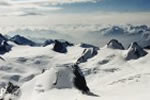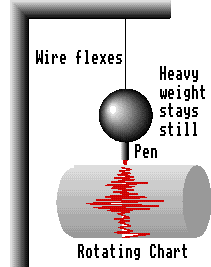


 |
 |
 |
Detecting an earthquake is much easier than predicting one. At its most simple level, a powerful earthquake can be felt by people in the area, and the damage it causes can be seen. The Mercalli scale is based on direct observations of this type. During a series of earthquakes in the Mississippi Valley, USA during 1811 and 1812 people were awakened by the rattling of ornaments and walls, and church bells in Boston, almost 2000km away, rung unattended due to the vibrations. At a great distance from the focus, or when the earthquake is small, direct observations are far less reliable.
Mechanical devices have existed to detect earthquakes for hundreds of years. The ancient Chinese are known to have had a device which consisted of four dragon heads, each facing one of the cardinal points of the compass. In each mouth was an iron ball, and below the mouth was a container. When an earthquake struck, the ball would fall from the dragon's mouth into the container. The direction from which the shockwaves originated was shown by reference to which balls had fallen.
Today, vibrations caused by the shock waves are still used to detect any movement, but the equipment is far more sophisticated. Many modern examples are so delicate that they are installed underground away from other sources of vibration such as traffic and even footsteps.
These machines, known as seismometers, or seismographs, if they can record the movements automatically, work on a simple principle; that a heavy weight suspended on a wire will remain steady as the vibrations pass, whilst the frame holding it will be vibrated.
Some vibrations will be in the vertical plain and will move the ground up and down; others in the horizontal plain will move the ground from side to side. To record both movements, two seismographs are needed, one for each plain.
The diagram below shows a simple seismograph to detect horizontal movement. As the ground is vibrated, the whole frame moves with it, but due to its mass, the weight remains steady. The pen attached to the weight stays still whilst the chart below it moves, thus leaving a record of the event. This idea can be difficult to understand at first, since we are used to moving the pen, not the paper, when we write or draw.

Two such devices will usually be installed, on facing North - South and the other facing East - West. To detect vertical movements the weight is mounted on a hinged arm held horizontal by a spring. As the frame moves up and down the weight again remains still as the spring flexes.
We value
your ideas and suggestions. Please contact the
maintainer of this site.
This page
can be found at: http://www.geography-site.co.uk
Last update to
this statement was on:
February 22, 2006
© Copyright Geography Site